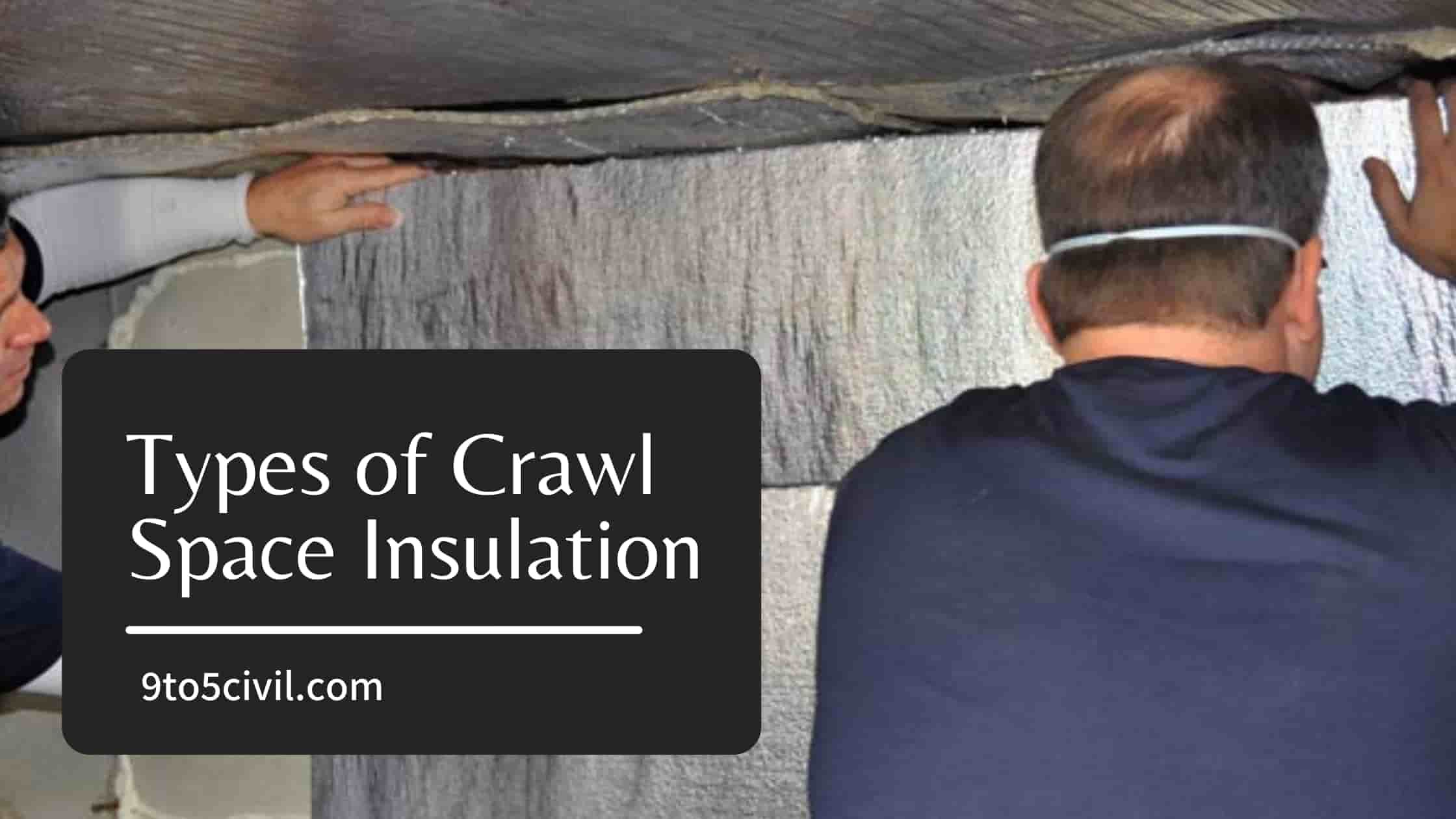
Types of Crawl Space Insulation
Crawl space insulation is done to keep the house warm and moisture-free. It prevents moisture and dirt to come inside the house. By this, the walls and foundation of the house were kept safe.
People who want their houses to be protected insulate their crawl space. There are many types of insulation to choose from. And there are advantages and disadvantages of this insulation which we will go to learn in the article.
What Is Crawl Space?
The Crawl space can be defined as a shallow unfinished space beneath the first floor or under the roof of the structure which is especially for the access of the wirings or plumbing purposes.
The Crawl spaces are sometimes also used for the storage of the different items and goods. The crawl space is similar to the basement of the structure.
Also Read: What is Drain Tile? | How to Install Drain Tile Around Foundation
Types of Crawl Space Insulation
There are four different types of crawl space insulation. Below there are explained in detail for better understanding. Knowing about them and their advantages and disadvantages will help you to choose better crawl space insulation for your house. So the different types of crawl space insulation are:
1. Fiberglass Batt Insulation
It is one of the most common crawl space insulation used by homeowners. It comes in rolls with various R values with a low to middle range of insulating capacity. It is most readily available. It can be installed by yourself easily. The downside is it is prone to moisture. So it has to be installed in a humidity-less area. Otherwise, it will sag and the capability of insulating will eliminate.
2. Foam Board Insulation
Foam board insulation is rigid boards. It gives the best insulating capability. It has the highest R-value among all of the crawl space insulation. It resists the moisture of the crawl space well. It acts as a vapor barrier and can be put directly on the foundation wall.
The problem comes because of its rigidity, because of that the installation can be troublesome and impractical for crawl space with the limited footprint irregularities and accessibility. It’s best to be installed by professional staff.
3. Spray Foam Insulation
Open cell and closed cell spray foam insulation provide the best coverage and seal areas that allow air leaks to pass air with the insulating. It comes in different types of R-value and but it has the best insulating capacity. It resists moisture, mold growth, and mildew formation.
It can be seen as the ideal type of insulation for crawl space. Closed-cell foam is the best moisture resistant. It works wonders for high humidity areas. It can be applied to all the areas under the home not only in the crawl space. It is expensive to install and can’t be done without professional help.
4. Blown-In Insulation
Blown-in insulation is consists of free-floating pieces of insulating foam that get blown into an area of crawl space. In crawl space, those pieces settle down to the ground and protect the space from outdoor temperatures.
It is best for under-home areas with limited entry sites. It is applied with the help of a hose. No need to enter the crawl space for the installation of these.
Also Read: Crawl Space Foundation | What Is Crawl Space Foundation? | How to Build a Crawl Space Foundation?
How to Insulate a Crawl Space?
Requirements for insulation of Crawl Space
- Caulking gun
- Utility knife
- Flashlight
- Rake and Shovel fine toothed saw
Materials
- The adhesive used in construction
- Polystyrene foam board
- Latex adhesive for foam board
- Polyethylene plastic of minimum 6-mm thickness
- Double-sided tape
- Poly PVC tape
- Foam insulation.
Also Read: Thermal Insulation Mean | Thermal Insulation Materials | Thermal Insulation Benefits
How to Install Insulation in Crawl Space?
The list of steps to insulate crawl space are as follows.
1. Prevention of moisture from Crawl Space
Check the crawl space for any kind of source of moisture. If you find that then change the pipelines or systems which give out the moisture to the foundation walls or crawl space by using a shovel and rake. Accumulate soil outside the house to move the water away from the structure.
2. Check all the interior for sources of moisture
Inside the house in the crawl space check for any source of moisture. Check all the areas of the crawl space for any kind of water leaking and moisture using a flashlight. Check the pipelines and inside joists properly. Give special attention to the place where water is regularly used like bathtubs, showers, dishwashers, and sinks.
3. Seal doors and Vents of Crawl Space from outside
Seal all the vents, doors, or hatches from outside that opens up in the crawl space. Then by using a caulking gun with exterior-grade caulk and insert caulk into cracks and holes.
4. Seal Sills and Rim joists
During daytime seal all the sills and Rim joists. Then turn all the artificial light off and go inside the crawl space and check if there is any form of light coming from rim joists and sill areas from outside. If you find any light coming inside the crawl space then seal all the cracks and gaps using silicone caulk. And for large cracks use low-expansion foam insulation for sealing.
5. Insulate the Crawl Space Walls
Using a saw cut rigid pieces of foam and then attach them inside the crawl space walls with the latex adhesive. Install large sheets on the seams using PVC tape. Aim for a few of the seams first for proper installation. After that check the insulation system properly.
6. Lay Vapor Barrier on the ground
Put the vapor barrier on the entire Crawl space ground. Make cutouts for every protrusion like piers and posts. Lay the vapor barrier against the protrusions and seal them up tightly using butyl tape. Seal all the seams between different vapor barrier sheets. Run up the vapor barrier of about 12 inches on the insulated walls and tape down the edges of the insulation system.
Also Read: What Is Porch Foundation? | Porch Foundation Options | How to Build a Porch Foundation?
Insulating a Vented Crawl Space
Insulating vented crawl space requires encapsulation of the crawl space which will protect the house from moisture and outside temperatures. In this, the crawl space is fully sealed without leaving any space for air leaks.
Insulating an Unvented Crawl Space
Insulating an unvented crawl space required installing a dehumidifier to control the level of humidity in the house. Because of the dehumidifier, the moisture will be reduced in the household and protect the wall from any damage. It is cheaper than vented crawl space but not in a condition long term.
Also Read: What Is Foundation Failure? | Signs of Foundation Failure | Causes of Foundation Failure
Advantages of Insulating the Crawl Space
There are various advantages of insulating the crawl space which are as follows:
- Prevent pests from entering your home: Crawl space insulation is done by sealing the crawl space fully. So the pests can not enter through the space. So basically it prevents the pest to enter the house. Though you have to check the house before for any type of insect infestation, if there is then you have to take care of it. But for the future, the crawl space sealing prevents insects from coming inside your home. You can also ask your contractor for a specific pest control barrier.
- Once you insulate your crawl space and make it air-tight. Then the air will not transfer outside whether it is cool or hot air. And it will save the energy of the house. So the HVAC system in your home doesn’t have to work hard to keep the house warm in winter and cool in summer.
- It reduces the cost of the energy of your house in long term and conserves the energy used in your home.
- Reduce the moisture potential: Humidity in the house can cause many problems like mold, mildew, and fungal growth. Which will lead to big damage in the long term if not treated at right time. This can cause problems for your family who have problems like asthma and allergies.
- For this, you have to hire a professional mild remover for eradication of that. The insulated crawl space is sealed properly so no air can pass from outside. So it helps in moisture prevention. It also helps in protecting your home’s foundation. Moisture can damage the structural integrity of the house. So by airtight barrier keep the house safe from moisture.
- Improve the home’s indoor quality: It improves home indoor quality because the dust and dirt don’t come inside the house through the crawl space. And it also prevents moisture because of which the walls in the house are intact without any damage and it is also odorless.
- If there will be moisture in the house it can cause some bad odor. So basically, it made the house comfortable and clean from outdoor dirt.
- Add storage space: The encapsulated crawl space is dry, clean, and airtight. It can be treated as a storage space it has an easily accessible door. It should be totally airtight to be used as a storage room in the house. It can add extra space to the house if you want to have it.
Also Read: What Is Roof Eaves? | Different Types of Eaves Styles | Roof Eaves Repair Cost
Disadvantages of Insulating the Crawl Space
There are also some of the disadvantages of insulating the crawl space which are as follows
- Cost required: The cost of insulating the crawl space is one of the cons of this. As it cost money to insulate the crawl space. The cost can vary from $1,500 to $15000 depending on many things like the type of insulation used, the size of the house, condition of the crawl space, labor included. Then many additional things can be added if you want some other things to install or repair. So it is an expensive business to insulate crawl space.
- Need more maintenance: You have to frequently check the crawl space after the insulation is installed. You have to keep it clean. And you have to add it in the inspection checklist of your house with other things. If there any problem occurs you have to repair it properly as soon as you can.
- Potential HVAC upgrade: If you encapsulate your crawl space then the movement of air will be limited. And the HVAC system you used is designed with the former air circulation in mind. It may cause some problems.
- If your house HVAC system doesn’t work after the encapsulation of the crawl space then you may have to change the system with an upgraded version. To have proper hot and cool air you may have to upgrade it.
- Consideration for insulating a Crawl Space: Some things you have to consider before insulating the crawl space other than the cost of the installation and the ease of access to the crawl space.
- Location: The location of your home is a very important thing to see when you consider insulating the crawl space of your house. R-value of the insulation gives the insulating capability.
- If you live in a house that is located in a cold place or most of the time the weather is cold so it’s better to choose insulation with a high R-value. Batt and Blown-in insulation which has low R-value are not suitable for cold places.
- Size: The size of the house also plays a role in determining with insulation to install in your house. If your house is big the insulation will cost more but you can choose which type to install by comparing the cost of the different types of insulation.
- Foam boards for a big house will be very expensive. If you have a vast crawl space and moderate temperature that you can use blown-in insulation. It will be suitable for that. The more the area needs to insulate that will cost more money.
- Type of insulation: It is one of the main considerations to do before insulating crawl space. Different types of insulation have different advantages over other types. Like foam, board costs double in comparison to blown-in. And labor-cost will increase the amount of money more.
- Some are can be done by yourself and some need mandatory professional help. Some work well in cold temperatures and some don’t.
- Vented or Unvented: It also plays an important role whether you use vented or unvented crawl space insulation. The cost gets majorly affected by this. If you install an unvented crawl space insulation then to control humidity level you have to install a dehumidifier. And if you install vented crawl space insulation. First, you have to do the encapsulation. It will seal all the cracks. It will protect the house from moisture and unwanted drafts from entering your crawl space.
- In general, the crawl space should be sealed. Professional suggest sealing of crawl space if there is any moisture problem in the house.
Also Read: What Is Stucco? | Different Types of Stucco | Stucco Application Systems
Cost to Insulate Crawl Space
So here are costs for different types of crawl space insulation:
- Fiberglass Batt insulation cost: $1750 for 1000 square foot crawl space.
- Foam Board Insulation cost: $2000 for 1000 square crawl space.
- Spray Foam Insulation cost: $2500 for 1000 square foot crawl space.
- Blown-in Insulation cost: $1250 for 1000 square foot crawl space.
Average Cost to Insulate Crawl Space
The average cost for a 1,000 square foot Crawl Space Insulation can be around $ 1,950 or 9 1.95 per square foot. Many homeowners insulate crawl space manually, which saves on labor costs.
Cost to Replace Insulation in Crawl Space
Cost to Replace Insulation in Crawl Space costs an average of $ 2,500 to $ 8,000.
Conclusion
Insulation of crawl space is done to make your house warm and it also protects the house from outside moisture as for this the crawl space is fully sealed. So everything you have to know about crawl space insulation is there in the above article.
Like what types of crawl space insulation is there, which one will suit which type of house, and the cost of the crawl space insulation. Hope you get all the information you were looking for. Thank you for reading the article till the end.
Frequently Asked Questions (FAQ)
What Type of Insulation for Crawl Space?
A rigid foam insulation board is the best insulation material for crawl spaces. Is appropriate to use. Instead of installing foam insulation between floor joists in the crawl space, use a rigid foam insulation board. It is installed against the walls of the crawl foundation.
How to Insulate a Crawl Space with Foam Board?
Cut each sheet of rigid foam insulation board accordingly to fit the crawl space wall height. Use a straight edge and utility knife to slice properly from this insulation board.
How to Insulate a Crawl Space Ceiling?
The first suitable insulation material is selected for Crawl Space Ceiling. It is important to wear protective gear before its insulation. Secondly, it is an important step to properly seal the seals around the band joist/rim joist of the Ceiling. Then insulate the rim joists with foam board or off-cell spray foam.
How Much Does It Cost to Insulate a Crawl Space?
The average cost for a 1,000 square foot Crawl Space Insulation can be around $ 1,950 or 9 1.95 per square foot. Many homeowners insulate crawl space manually, which saves on labor costs.
How Much to Insulate Crawl Space?
The average cost of insulating crawl space can be approximately $ 0.95 per square foot. The approximate total cost of labor and materials per square foot can be between $ 1.18 and $ 2.65.
Cost to Remove Insulation from Crawl Space
Removing and replacing damaged insulation from a crawl space can cost 1,500 to $ 3,000.
Labor Cost to Install Insulation in Crawl Space
The labor cost to install crawl space insulation is about $ 0.25 to $ 0.50 per square foot. Overall labor costs depend on the type of insulation. Batting crawl space insulation is a quick installation process. While spray foam requires more time and preparation.
Crawl Space Foam Insulation Cost
Spray Foam Insulation cost: $2500 for 1000 square foot crawl space.
Like this post? Share it with your friends!
Suggested Read –
- Low Income Roof Repair Assistance | Roofing Programs for Low Income Families
- Catslide Roof | What Is Catslide Roof? | Advantages & Disadvantages of Catslide Roof
- Rubble Trench Foundation | What Is Rubble Trench Foundation? | How to Build a Rubble Trench Foundation?
- Sandblasted Finish Concrete | What Is Sandblasted Concrete Finish? | Process of Sandblasting Concrete Finish
- Floor Joists | What Is Floor Joists? | Pros And Cons of Floor Joists | Floor Trusses vs Floor Joist
 Skip to content
Skip to content


